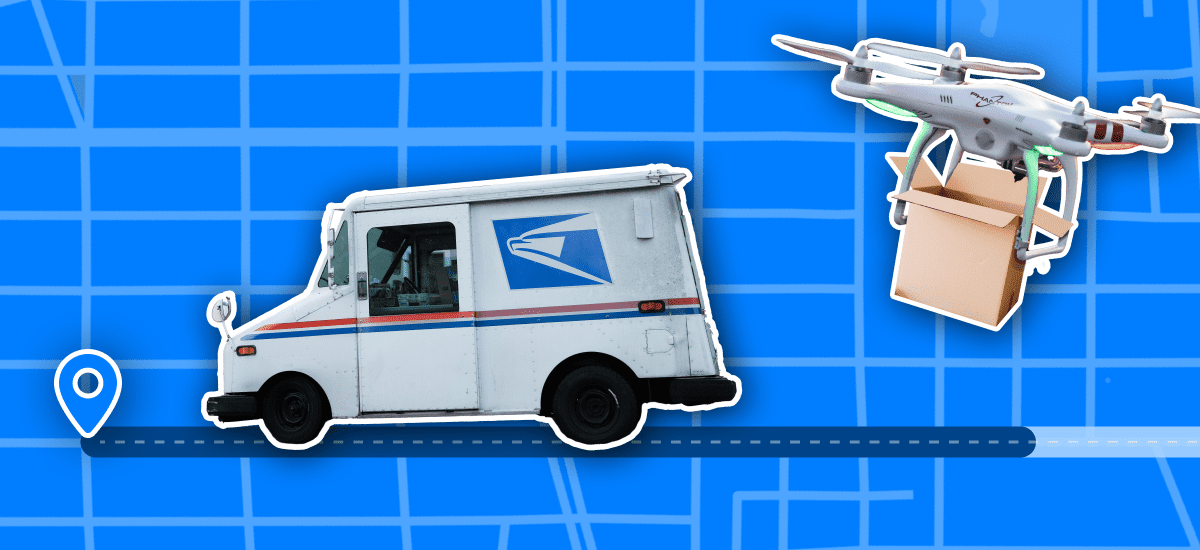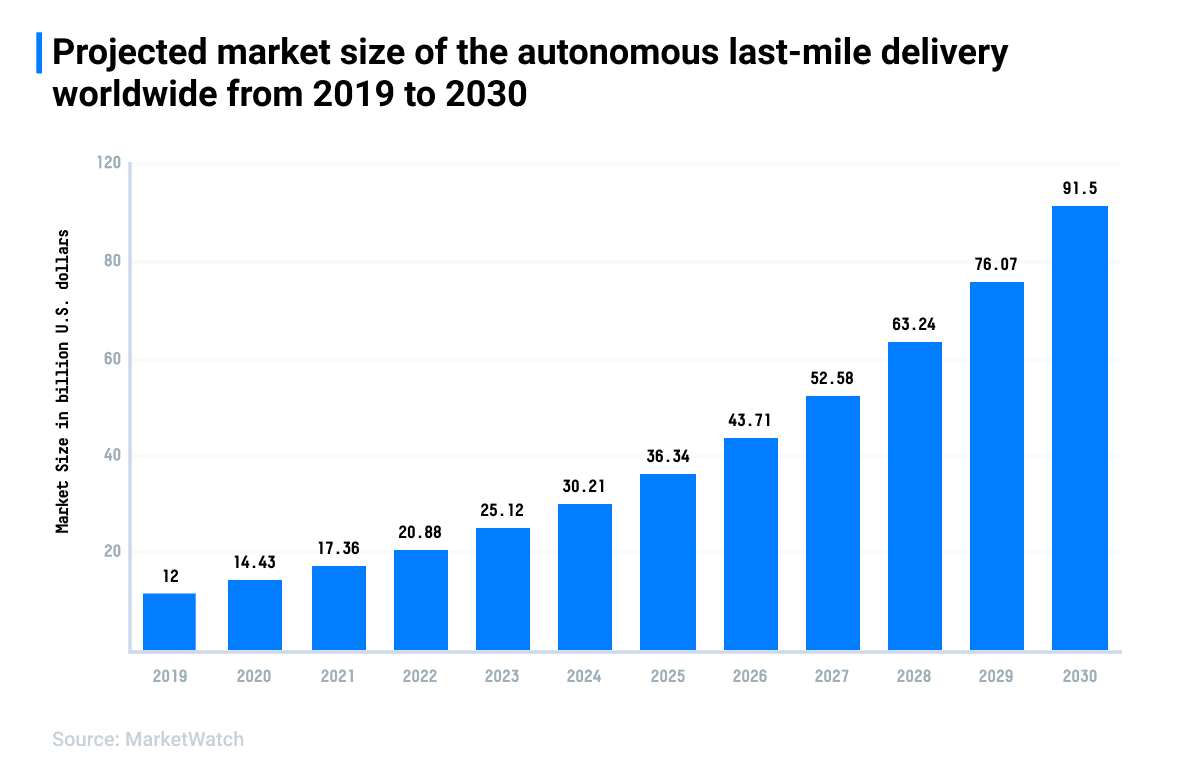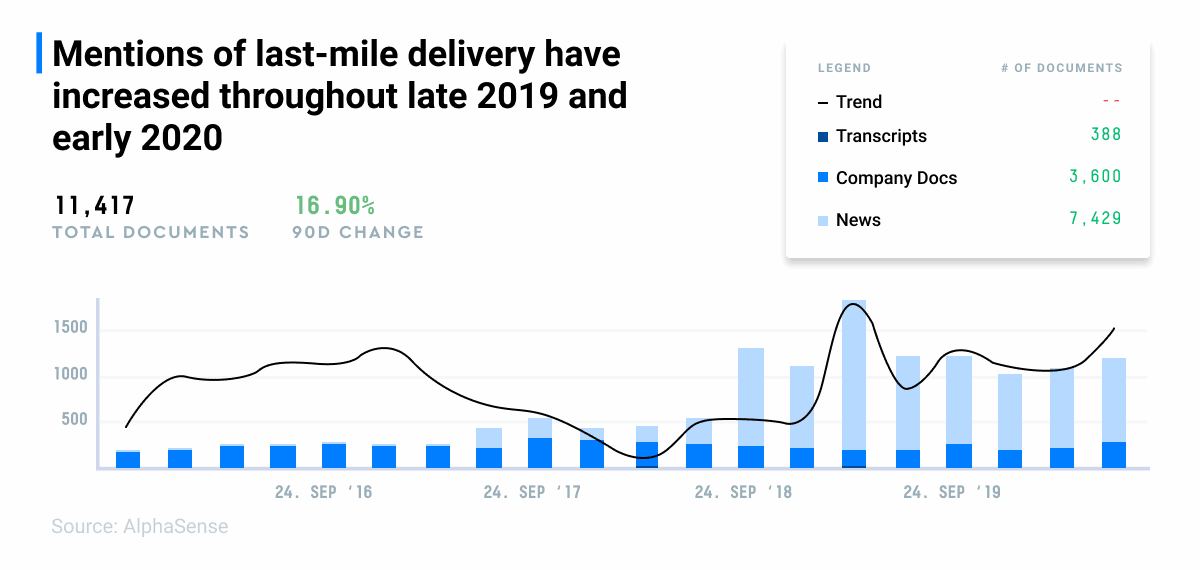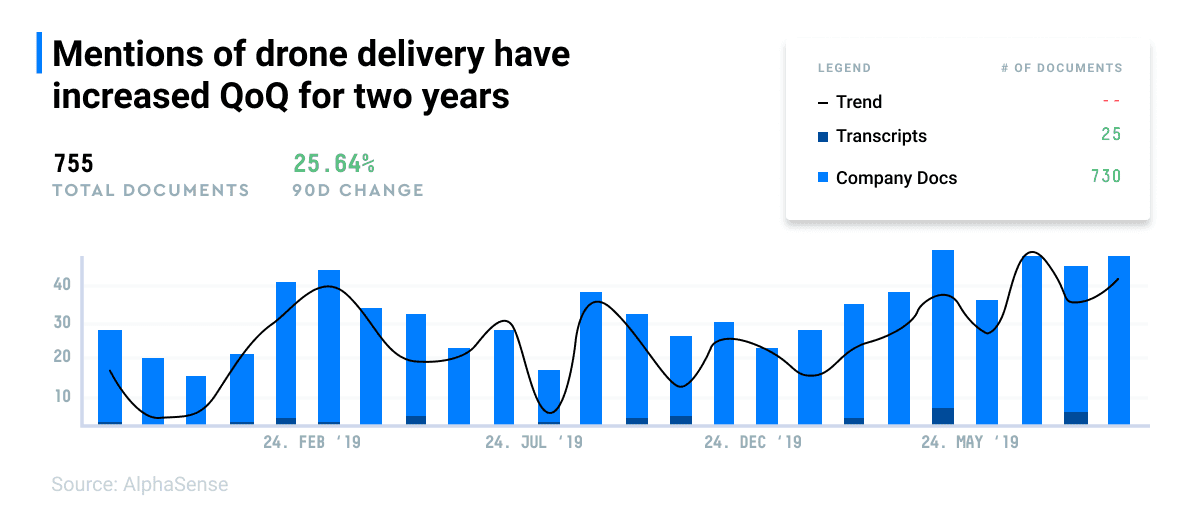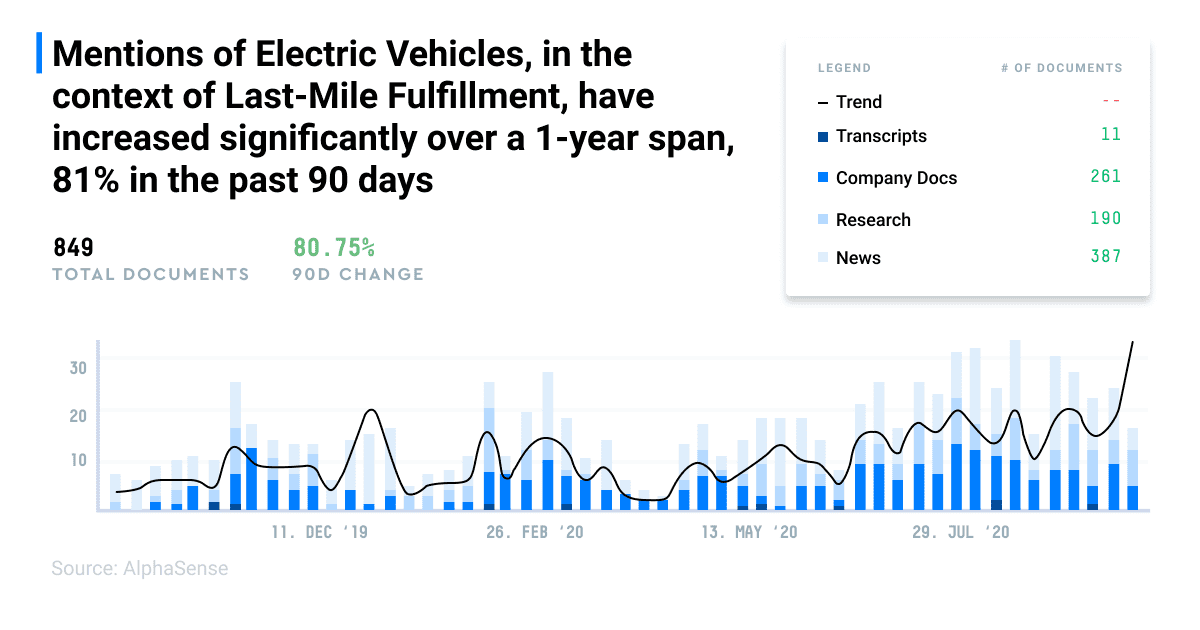Before COVID hit, last-mile delivery was a problem for retailers competing against Amazon Prime. Fast, reliable delivery for goods and services was not “best practice” for businesses—it was an expectation set by consumers. With e-commerce sales surging past 20% during the pandemic, customers now rely on “free 2-day delivery”—they don’t simply want the best deal; they need their package now.
Developing new technology and supply chain models to expedite deliveries, increase volume, and cut costs has been at the top of mind for retailers everywhere. Shopping center operators have even had discussions about turning their empty department stores into last-mile distribution centers.
Aerial delivery drones lead the growth of autonomous last-mile delivery. With technological advances and new supply chain models, the autonomous last-mile delivery market will grow to $91.5 billion by 2030.
Source: MarketWatch | Projected market size of the autonomous last-mile delivery worldwide from 2019 to 2030
You can use AlphaSense to keep track of companies who are competing in the last-mile delivery space–whether tracking drone delivery, autonomous vehicle delivery, or general last-mile commentary. To customize your search, login to AlphaSense or sign up for a free trial.
Takeaways:
- Last-mile delivery accounts for 53% of shipping costs, and costs an average of $10.1 per package delivered.
- Drone technology is rapidly becoming a viable solution for last-mile fulfillment, with major players like Walmart, Workhouse, and Drone Delivery Canada Corp racing to the front lines
- JLL is offering full retail services, while transforming empty retail spaces to make last-mile delivery more convenient
- Last-mile delivery does not just affect e-commerce and DTC retail companies; food delivery, supermarkets, pharmacies, logistics companies, and couriers are all affected by last-mile inefficiencies.
Quick Recap
What is last-mile delivery? Last-mile delivery is the final step of a shipment from warehouse to doorstep. It is also the most expensive part of the delivery process.
Mentions of last-mile delivery have increased throughout late 2019 and early 2020.
What is the last-mile problem? Last-mile, generally, is inefficient because shipments involve many stops with small package sizes. In cities, deliveries can be held up in traffic and delays, while in rural areas, only a few packages are delivered to vast areas. Add in the expectations that e-commerce giants like Amazon have created, and customers now expect cheap (or free), fast delivery.
How much does last-mile delivery cost? Last-mile delivery comprises 53% of shipping costs. Free shipping forces retailers to take on the cost, which averages about $10 per shipment.
Solutions for Last-Mile Delivery
1. Transforming Empty Retail Spaces
JLL announced the formation of the Retail Industrial Task Force in 2018, a unit that will employ members of its industrial real estate team to advise retailers and center owners and operators on supply chain management, e-commerce distribution, and urban logistics, among other topics.
“Pre-COVID, only the top global retailers were truly investing in and focusing on the last-mile. Now we see a tremendous opportunity to help all retailers…with every area of expertise required today,” said Kris Bjorson, head of Retail E-commerce Distribution at JLL.
2. Drone Delivery
On September 16th, Amazon received approval from the US Federal Aviation Administration (FAA) that allows the e-commerce giant to start testing its commercial drone delivery service. Amazon isn’t the only player competing for expedited drone delivery, though.
Mentions of drone delivery have increased QoQ for two years
Walmart announced that it will start a pilot program with drone company Flytrex to deliver groceries and other household essentials from its stores in Fayetteville, NC.
Workhorse Group is an American technology company focused on providing sustainable and cost-effective drone-integrated electric vehicles to the last-mile delivery sector, announced that its C-Series all-electric delivery trucks have achieved an improved and industry-leading range. New data from testing showed that Workhorse’s 2020 model year C-1000 Extended Range achieved a maximum of approximately 160 miles per charge under urban situations.
Ascend Delivery is a drone delivery service company that’s working to make last-mile drone delivery more affordable. With its drone, called “Tars,” Ascend’s device has an array of abilities like full autonomy, machine learning recognition landing and waypoint mission capabilities. Tars requires zero human interaction and can facilitate deliveries all on its own, the company says, adding that Tars’ autonomy allows for scalability as Ascend grows its fleet of drones.
Drone Delivery Canada Corp is focused on designing, developing and implementing a commercially viable drone delivery system within Canada.
Volansi is a developer of logistics solutions through autonomous drone deliveries that facilitate long range, time-critical shipments. Volansi is the leader in vertical take-off and landing (VTOL) middle-mile drone delivery services, today announced that it has closed $50 million in a Series B round of funding.
3. Electric Vehicle Delivery Improvements and Driverless Delivery
Energy-efficient driving options and automated vehicles are also making an impact on last-mile fulfillment improvements.
Mentions of Electric Vehicles, in the context of Last-Mile Fulfillment, have increased significantly over a 1-year span, 81% in the past 90 days.
Amazon: in July Amazon planned to acquire Zoox, a self-driving startup founded in 2014 that has raised nearly $1 billion in funding and which aims to develop autonomous driving technology, including vehicles, for the purposes of providing a full-stack solution for ride-hailing. Additionally, Amazon created its very own robot, Scout, which will carry packages autonomously the “last-mile,” from delivery hubs to homes.
Workhorse: In July, the Company announced that it had been awarded Executive Order: A-445-0003 from the California Air Resources Board (“CARB”), which designates the C-Series trucks as zero-emission vehicles in the state of California.
You can use AlphaSense to keep track of companies who are competing in the last-mile delivery space–whether tracking drone delivery, autonomous vehicle delivery, or general last-mile commentary. To customize alerts, log in to AlphaSense, or start a free trial.
